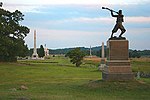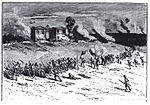Gettysburg National Tower
1974 establishments in Pennsylvania2000 disestablishments in PennsylvaniaBuildings and structures demolished by controlled implosionBuildings and structures demolished in 2000Demolished buildings and structures in Pennsylvania ... and 5 more
Former towersGettysburg BattlefieldHyperboloid structuresTowers completed in 1974Towers in Pennsylvania
The Gettysburg National Tower was a 307-foot (94 m) hyperboloid observation tower that overlooked the Gettysburg National Military Park and Gettysburg, Pennsylvania, from 1974 to 2000. The privately owned tower attracted many of the battlefield's visitors, who paid a fee to access its observation decks.Controversial even before it opened, the structure was eventually seized by eminent domain and demolished.
Excerpt from the Wikipedia article Gettysburg National Tower (License: CC BY-SA 3.0, Authors).Gettysburg National Tower
Hunt Avenue,
Geographical coordinates (GPS) Address Nearby Places Show on map
Geographical coordinates (GPS)
| Latitude | Longitude |
|---|---|
| N 39.815 ° | E -77.230555555556 ° |
Address
Hunt Avenue
Hunt Avenue
17325
Pennsylvania, United States
Open on Google Maps










